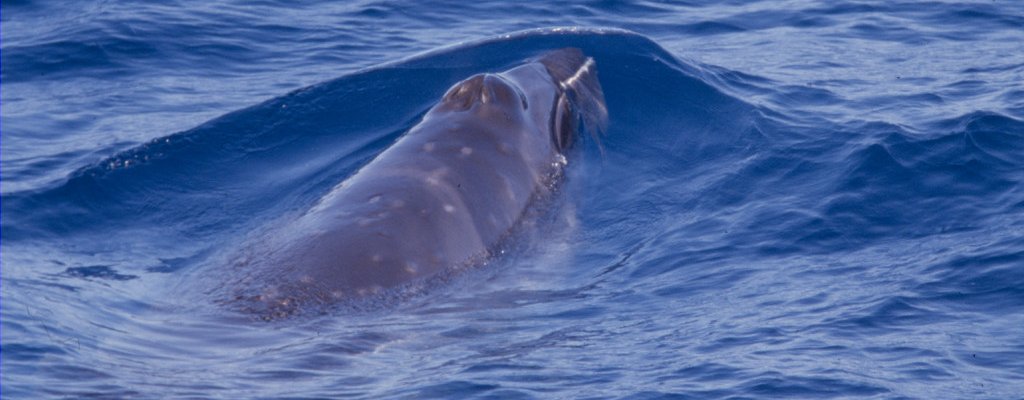Pygmy right whale
(Caperea marginata)

Description
The pygmy right whale (Caperea marginata) is a member of the cetotheres,a family of baleen whales,which until 2012 were thought to be extinct;previously C.marginata was considered the sole member of the family Neobalaenidae.First described by John Edward Gray in 1846,it is the smallest of the baleen whales,ranging between 6 and 6.5 metres (20 and 21 ft) in length and 3,000 and 3,500 kilograms (6,610 and 7,720 lb) in mass.Despite its name,the pygmy right whale may have more in common with the gray whale and rorquals than the bowhead and right whales.The pygmy right whale is found in the Southern Ocean in the lower reaches of the Southern Hemisphere,and feeds on copepods and euphausiids.Little is known about its population or social habits.Unlike most other baleen whales,it has rarely been subject to exploitation.The pygmy right whale is rarely encountered and consequently little studied.However,it is known that it is by far the smallest of the baleen whales.Calves are estimated to be about 1.6 metres (5 ft 3 in) to 2.2 metres (7 ft 3 in) at birth (a 2 metres (6 ft 7 in) fetus was reported from a 6 metres (20 ft) female).By the time they are weaned,they may be about 3 to 3.5 metres (9.8 to 11.5 ft) long.It is believed they become sexually mature at about 5 metres (16 ft) and physically mature at about 6 metres (20 ft).The longest male registered,was a 6.1 metres (20 ft) individual which had stranded in Cloudy Bay,Tasmania,while the longest female was a 6.45 metres (21.2 ft) individual which had stranded in Stanley,Tasmania.Pygmy right whales can weigh as much as 3,430 kilograms (7,560 lb).A 6.21 metres (20.4 ft) female weighed 3,200 kilograms (7,100 lb) and a 5.47 metres (17.9 ft) male weighed 2,850 kilograms (6,280 lb).Gestation and lactation periods and longevity are all unknown.Part of the reason for the scarcity of data may be the relative inactivity of the whale,making location for study difficult.The blow is small and indistinct and the whale is usually a slow undulating swimmer,although capable of bursts of acceleration.The coloring and shape of the pygmy right whale,dark gray dorsally and lighter gray ventrally,commonly with a pair of chevron-shaped lighter patches behind the eyes,is similar to that of the dwarf minke and Antarctic minke whales and at sea the species may easily be confused with these two species,in case the jaw and flippers are not carefully observed.The arched jawline is not as pronounced as other right whales and may not be sufficient to distinguish a pygmy right whale from a minke whale.The long,narrow cream-coloured baleen plates with a distinctive white gumline are the most effective discriminators.Unlike true right whales,pygmy rights do not have callosities.The dorsal fin is falcate (crescent-shaped) and located about three-quarters of the way along the back of the animal.Unlike the minke whales,occasionally the dorsal will not be seen on the whale surfacing.Like the minkes,though,it doesn't raise its flukes when it dives.The skull and skeleton of the pygmy right whale is unlike those of any other extant whale: the supraoccipital shield extends farther posteriorly;the ear bone has a lateral wrinkle and is roughly square in outline.All seven cervical vertebrae are fused,and the pygmy right has only 44 vertebrae.The 18 pairs of ribs are broad and flat,and make up 39–45% of the vertebral column (compared to 33% in other mysticetes).Each thoracic vertebrae has a pair of huge wing-like transverse processes,many of which overlap.The dorsal end of the ribs are remarkably thin and almost fail to make contact with the transverse processes.The reduced tail (or sacrocaudal region) features a vestigial pelvis and small chevron bones.The flippers have four digits.The lungs and heart are relatively small,which suggests that the pygmy right whale is not a deep diver.The larynx is reported to be different from any other cetacean.Like other mysticetes,the pygmy right whale has a large laryngeal sac,but in contrast to other mysticetes,this sac is positioned on the right side of the midline in the pygmy right.The presence of this laryngeal sac can possibly be the explanation for the long thorax and flattened ribs,but the peculiar ribs have been the source many speculations.Analysis of the stomach contents of dead pygmy right whales indicates that it feeds on copepods and euphausiids.The social and mating structures are unknown.The whale is typically seen alone or in pairs,sometimes associated with other cetaceans (including dolphins,pilot whales,minke whales,and once a sei whale cow and calf).Occasionally larger groups are seen — in 2001 a group of 14 were seen at 46°S in the South Pacific about 450 km southeast of New Zealand,while in 1992 a group of about 80 individuals were seen 320 nautical miles (590 km) southwest of Cape Leeuwin and another group of over 100 individuals were sighted in June 2007 about 40 kilometres (25 mi) southwest of Portland,Victoria.
Taxonomic tree:







